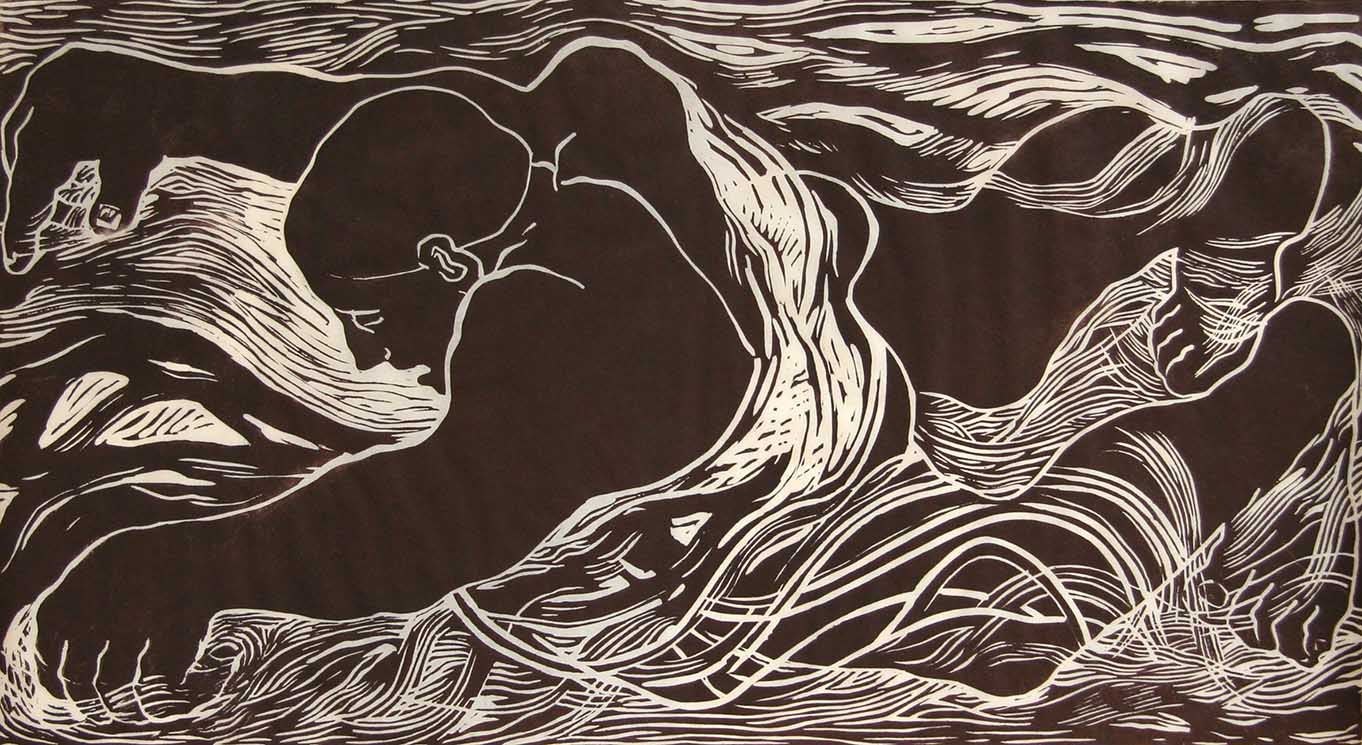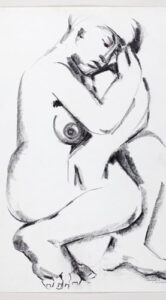
The Exhibition

Delacroix Venus, 1978
mixed media on paper.
Estate of Hilda M. Woolnough
Hilda Woolnough’s impact on the visual arts in Prince Edward Island has been immense. Many of the Island’s arts institutions, art scenes, even conversations and attitudes about art, can be traced to her influence. The Confederation Centre Art Gallery is honoured to present this retrospective exhibition of her significant work as a visual artist, showcasing the great variety of Woolnough’s production beginning in the early 1960s.
Born in Northampton, England in 1934, Hilda Woolnough attended the Chelsea School of Art in London from 1952 to 1955. Studying under Julian Trevelyan, Ceri Richards, and Bernard Meadows, among others, she was trained according to a method that placed great emphasis on drawing, technical facility, graphic visual impact, and an experimental approach to the making of pictures. Although Woolnough worked in many mediums, including painting, textile design and sculpture, her practice was fundamentally based on her skilled and dynamic drawing and her innovative exploration of the materials and techniques of printmaking. From the very beginning, Woolnough was prolific and she often worked quickly, preferring medium-scale works on paper, developing series as a way of employing a variety of techniques in the elaboration of a visual motif or theme.
In 1957, Woolnough immigrated to Canada, settling in Hamilton, Ontario. Her connection to the Confederation Centre Art Gallery, which has consistently collected and shown her work, began in 1964; one of the first purchases in its history was her linocut Butterfly No.3, a piece exemplary of the earliest part of her career when she focused on printmaking. In 1969, following further studies in London and Mexico, where she received her MFA at the Instituto Allende in San Miguel de Allende, Woolnough settled in Charlottetown, Prince Edward Island. There she formed a formidable partnership with her husband Reshard Gool, a writer and professor at the University of Prince Edward Island. The two were central figures in a growing artistic and literary scene in the province, and were behind the founding of a series of artist-run centres, children’s art exhibitions, an alternative newspaper, and a publishing house, Square Deal Press. Woolnough became a driving force in many artistic organizations in Prince Edward Island, including the Phoenix Gallery, the Great George Street Gallery, the PEI Printmakers’ Council, the P.E.I. Council of the Arts, and the Arts Guild. A series of quilts designed by Woolnough and executed by Island crafters is powerful evidence of her engagement with the creative community on the Island.
Even as Hilda Woolnough threw herself into helping build and sustain an artistic scene, with all its attendant administration and politics, she consistently pursued the elemental in her work. Natural processes, myth, birth, death, and the body, featured prominently as subject matter throughout her career. Even her method was implicated. In an interview with art historian Joan Murray in 1986, Woolnough noted that over time she had begun to distrust her own technical skill, and embraced frottage, stencil, and the indirect and sometimes accidental results of complex printmaking processes as ways of getting closer to her materials and manifesting a deep interest in the fundamental elements of creation.
Following a stroke suffered by her husband that would ultimately take his life in 1989, Woolnough’s interest in the elemental increasingly focused on the human body, often portrayed in extreme psychological or physical states, and the passage of time, most elaborately explored in the installation Timepiece, which showed at the Confederation Centre Art Gallery in 2001 and featured sculpture, sound environments, and complex multilayered prints. Her last major work, the installation Guantanamo, created in 2004 and 2005, developed a longstanding interest in the human figure at its existential limit into a powerful political statement.
Hilda Woolnough’s achievements were honoured repeatedly during her lifetime. She received the Father Adrien Arsenault Senior Arts Award recognizing achievement as a Prince Edward Island artist in 1999, and was elected to the Royal Canadian Academy in 2000. She passed away in 2007, and is still mourned by her many admirers, colleagues, and protégés on the Island and elsewhere. I consider myself one, and it is impossible for me not to add a personal note when writing about Hilda. She was a friend and a great mentor, an inspiration. I feel privileged to have been given the opportunity to celebrate her life and work through this exhibition.

Caryatid, 1986, graphite and watercolour on paper, 76.5 x 56.7 cm, 1998.97.10, Collection of Carleton University Art Gallery
Pan Wendt, curator



 About the Centre
About the Centre Support the Centre
Support the Centre Art Gallery
Art Gallery Arts Education
Arts Education Heritage
Heritage On Stage
On Stage